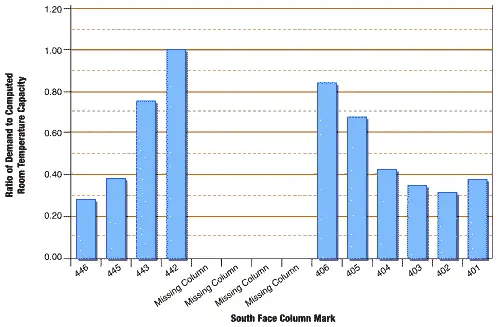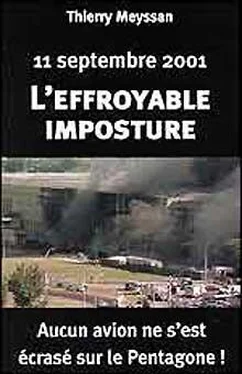
General notes:
(1) Column damage captured from photographs and enchanced video.
(2) Damage to column lines 413-418 at levels 81 and 82 is estimated.
(3) There is not sufficient information to detail damage to column lines 408-411 at levels 83-84.
Figure 2-27 Impact damage to exterior columns on thr south face of WTC 2.
A second analysis was conducted to estimate the demands on columns immediately following aircraft impact and before fire effects occurred. Exterior columns were removed from the model to match the damage pattern illustrated in Figure 2-27. Although some core columns were probably damaged by the aircraft impact, the exact extent of this damage is not known and therefore was not considered in the model. As a result, this analysis is thought to underestimate the true stress state in the columns immediately after impact. The analysis indicates that most of the loads initially carried by the damaged exterior columns were transferred by Vierendeel truss action to the remaining exterior columns immediately adjacent to the impact area. If the floors at this level are assumed to remain intact and capable of providing lateral support to the columns, this raised the utilization ratio for the most heavily loaded column immediately adjacent to the damage area to approximately a value of 1.0. At a value of 1.0, columns would lose stiffness and shift load to adjacent columns. Based on this analysis, it appears that the structure had significant remaining margin against collapse. However, this analysis does not consider damage to the building core, which was likely significant. Columns located further from the damage area are less severely impacted, and columns located only 20 feet away from the damaged area experience almost no increase in demand at all. These data are plotted in Figure 2-31.

Figure 2-31 Plot of column utilization ratio at the 80th floor of WTC 2, viewed looking outward. (Conservatively assumes columns 401-411 and 440-441 to be missing.)
The columns immediately above the damage area are predicted to act as tension members, transferring approximately 10 percent of the load initially carried by the damaged columns upward to the outrigger trusses, which, in turn, transfer this load back to the core columns. Not considering any damage to the core columns, utilization ratios on these elements are predicted to increase by about 20 percent at the 80th floor level. In upper stories, where the core columns were more lightly loaded, the increase in utilization ratio is substantially larger and may have approached a value of 1.0. These conditions would have been made more severe by damage to one or more core columns.
Following the impact, fires spread throughout WTC 2, similar to the manner previously described for WTC 1. Extensive videotape of the fires' development through the building was recorded from various exterior vantage points. This videotape suggests that, in the minutes immediately preceding the collapse, the most intensive fires occurred along the north face of the building, near the 80th floor level. Just prior to the collapse, a stream of molten material—possibly aluminum from the airliner—was seen streaming out of a window opening at the northeast corner at approximately this level. This is of particular interest because, although the building collapse appears to have initiated at this floor level, the initiation seems to have occurred at the southeast rather than the northeast corner.
Although less time was available for evacuation of WTC 2 than for WTC 1, and the aircraft hit the building some 16 floors lower than in WTC 1, fewer casualties occurred within this building. The reduced number of casualties to building occupants in WTC 2 may be attributed to the movement of some of the building occupants immediately after the aircraft impact into WTC 1 and before the second aircraft struck WTC 2. Several survivors from WTC 2 stated that, following the impact of the aircraft into WTC 1, a message was broadcast over the loudspeaker system indicating that WTC 2 was secure and that occupants should return to their offices (Scripps 2001, BBC News 2001). Many of these survivors did not heed the announcement and continued to exit the building, using the elevators. Survivors also related reports of individuals who listened to the message, returned to their floors, and did not make it out after the second aircraft impacted WTC 2. Some survivors related that a small number of people traveled to the roof under the assumption that a helicopter rescue was possible (Cauchon 2001b).
2.2.2.5 Initiation of Collapse
The same types of structural behaviors and failure mechanisms previously discussed are equally likely to have occurred in WTC 2, resulting in the initiation of progressive collapse, approximately 56 minutes after the aircraft impact. Review of video footage of the WTC 2 collapse suggests that it probably initiated with a partial collapse of the floor in the southeast corner of the building at approximately the 80th level. This appears to have been followed rapidly by collapse of the entire floor level along the east side, as evidenced by a line of dust blowing out of the side of the building. As this floor collapse occurred, columns along the east face of the building appear to buckle in the region of the collapsed floor, beginning at the south side and progressing to the north, causing the top of the building to rotate toward the east and south and to begin to collapse downward (Figure 2-32). It should be noted that failure of core columns in the southeast corner of the building could have preceded and triggered these events.
2.2.2.6 Progression of Collapse
As in WTC 1, a very large quantity of potential energy was stored in the building, during its construction. Once collapse initiated, much of this energy was rapidly released and converted into kinetic energy, in the form of the rapidly accelerating mass of the structure above the aircraft impact zone. The impact of this rapidly moving mass on the lower structure caused a wide range of structural failures in the floors directly at and below the aircraft impact zone, in turn causing failure of these floors. As additional floor plates failed, the mass associated with each of these floors joined that of the tower above the impact area, increasing the destructive energy on the floors immediately below. This initiated a chain of progressive failures that resulted in the total collapse of the building.
A review of aerial photographs of the site, following the collapse, as well as identification of pieces of structural steel from WTC 2, strongly suggests that while the top portion of the tower fell to the south and east, striking Liberty Street and the Bankers Trust building, the lower portion of the tower fell to the north and west, striking the Marriott Hotel (WTC 3). Again, the debris pattern spread laterally as far as approximately 400-500 feet from the base of the structure.
As first WTC 2, then WTC 1 collapsed, nearly 600,000 tons of debris fell onto the Plaza level, punching large holes through the Plaza and the six levels of substructure below, and partially filling the substructure with debris. This damage severely compromised the ability of the slabs to provide lateral bracing of the substructure walls against the induced lateral earth pressures from the unexcavated side. This condition was most severe at the southern side of the substructure, adjacent to WTC 2 and WTC 3. In this region, debris from the collapsed WTC 2 punched through several levels of substructure slab, but did not completely fill the void left behind, leaving the south wall of the substructure in an unbraced condition over a portion of its length.
Читать дальше














